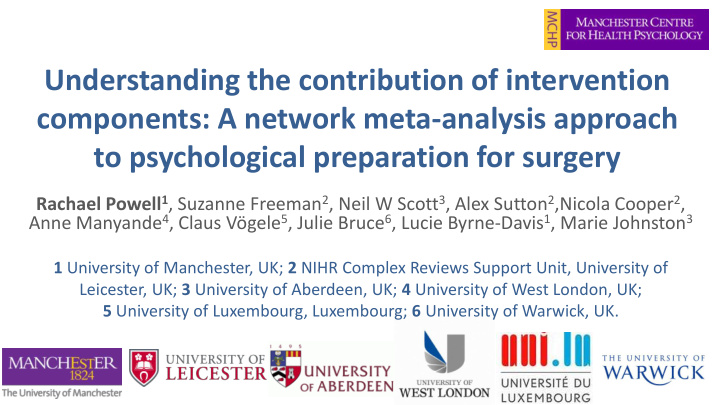



Understanding the contribution of intervention components: A network meta-analysis approach to psychological preparation for surgery Rachael Powell 1 , Suzanne Freeman 2 , Neil W Scott 3 , Alex Sutton 2 ,Nicola Cooper 2 , Anne Manyande 4 , Claus Vögele 5 , Julie Bruce 6 , Lucie Byrne-Davis 1 , Marie Johnston 3 1 University of Manchester, UK; 2 NIHR Complex Reviews Support Unit, University of Leicester, UK; 3 University of Aberdeen, UK; 4 University of West London, UK; 5 University of Luxembourg, Luxembourg; 6 University of Warwick, UK.
Systematic review & meta-analysis • Is there evidence for beneficial (or harmful) effects of psychological preparation for surgery? • Which outcomes (pain, behavioural recovery, length of stay, negative affect) are improved (or worsened) following preparation? Powell, Scott, Manyande, Bruce, Vögele, Byrne-Davis, Unsworth, Osmer, Johnston (2016). Cochrane Database of Systematic Reviews, Issue 5, Art.No.: CD008646.
Methods: inclusion criteria • Published and unpublished RCTs (NOT quasi-randomised); any language. • Adults, elective surgery under general anaesthetic. Intervention: pre-operative Outcomes: post-operative • P rocedural information • Pain • S ensory information • Negative affect • B ehavioural instruction • Length of stay • C ognitive intervention • Behavioural recovery • R elaxation • H ypnosis • E motion-focused intervention
6781 (databases) 151 (other sources) 5116 screened 4289 excluded (duplicates removed) 827 full-text assessed 712 excluded 115 papers, 105 studies Pain: 61 10,302 participants Behavioural recovery: 14 randomised Length of stay: 58 Negative affect: 50 Meta-analysis: Pain: 38 Behavioural recovery: 0 Length of stay: 36 Negative affect: 31
Cochrane Review Meta-analysis Results • Post-surgery, compared with controls, patients receiving interventions experienced: – Lower pain ( Hedges’ g = -0.20, 95%CI: -0.35 to -0.06) – Lower negative emotion ( Hedges’ g = -0.35, 95%CI: -0.54 to -0.16) – Shorter length of stay (mean difference = -0.52 days, 95% CI -0.82 to -0.22). • High heterogeneity – studies not very similar (different interventions, surgical populations).
Limitations of analysis • Could not effectively unpick impact of individual intervention components. – Interventions comprised 1 to 4 components. • Need to explore causes of heterogeneity.
Secondary analysis: Network meta-analysis • Statistical model using direct evidence (where two components are directly compared) and indirect evidence (where two components are each compared with a third treatment). • Outcome: estimate effects for each comparison, whether or not the treatments have been directly compared. • Can examine potential causes of heterogeneity (e.g. control group mean, type of surgery). • Bayesian framework in WinBUGS v1.4.3. Freeman, S.C., Scott, N.W., Powell, R., Johnston, M., Sutton, A.J., Cooper, N.J. (In prep).
Length of stay network diagram R C P+S B P+B S S+B P B+C Control B+R S+B+C+R P+S+B P+S+B+E P+S+C S+B+E P+S+R P+C+R P+B+E P = procedural information; S = sensory information; B = behavioural instruction; C = cognitive intervention; R = relaxation; E = emotion-focussed
Models • Model 1: as for Cochrane review – compares all interventions with control. • Model 2: each component has separate effect; total effect of an intervention = sum of component effects (e.g. P + S ). • Model 3: model 2 plus combinations of components (pairs of components when combined may have larger/smaller effect than if effects summed)(e.g. P + S + PS ). • Model 4: each possible combination treated as a separate intervention.
Model 2: role of components • P rocedural info, S ensory info , B ehavioural instruction, C ognitive intervention & R elaxation each reduced length of stay; greatest effects: – Relaxation (MD -0.48, CrI: -1.35, 0.36) and – Behavioural instruction (MD -0.42, 95%CrI: -0.97, 0.06). • In linear combination, reduction of approximately 1 day for – P+S+B (MD -0.96, 95% CrI: -1.62, -0.35) and – P+S+R (MD -1.02, 95%CrI: -2.00, -0.05). • Evidence of heterogeneity (τ=0.81).
Causes of heterogeneity 1 • Control group mean length of stay included as continuous covariate – Control for typical length of stay for that operation, at that time, in that context. – For every 1 day increase control LoS, mean reduction of 0.10 days in intervention group LoS (95%CrI -0.16, -0.04) – As control LoS increases, benefit of intervention on LoS increases. – Slightly reduced heterogeneity ( τ =0.76).
Causes of heterogeneity 2 • Type of surgery : cardiovascular / orthopaedic / ‘other’ – Reduced heterogeneity ( τ =0.68) – Procedural info = most effective intervention for orthopaedic surgery (MD -3.63 95%CrI -5.87, -1.34); – Sensory info for cardiovascular surgery (MD-1.50, 95%CrI- 3.12, 0.13) – Behavioural instruction for ‘other’ surgery (MD -1.06, 95% CrI -1.93, -0.30) • Including type of surgery AND control group mean reduced heterogeneity further (τ=0.54).
Conclusions • Component network meta- analysis → quantify effects for individual intervention components (not possible with standard Cochrane analysis). • Possible to control for other covariates to further understand heterogeneity. • Can model how effects of intervention components vary with covariates.
Recommend
More recommend